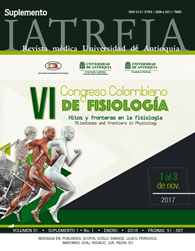Cellular plasticity in the vascular system: the good, the bad and the ugly
DOI:
https://doi.org/10.17533/udea.iatreia.329895Palabras clave:
.Resumen
All blood vessels in the body are lined with a single layer of endothelial cells (EC) on their luminal side. This intima, serves as a gate-keeper that controls passage of (immune) cells and large molecules. EC show a large variation of phenotypes: e.g. the barriers posed by brain EC and retinal EC are much tighter than in the fenestrated endothelial cells in glomeruli that have to filter blood, while e.g. postcapillary venule ECs serve to egress immune cells during damage control. Vascular EC are among the first cells to come into contact with (patho) physiological triggers such as hyperglycemia, pro-inflammatory cytokines, hypoxia and mechanical forces (blood pressure, shear stress and strain). Thus, EC dysfunction lurks around the corner continuously. To handle these ugly adverse stimuli and suppress dysfunction, EC are highly plastic. In general, chronic and persistent activation, contributes to EC dysfunction. These include pro-inflammatory activation, mitochondrial stress and ROS production, early senescence and in a worst case, endothelial to mesenchymal transition (EndMT) which is loss of EC features and gain of mesenchymal, fibrotic features. Activation of TGF-β signaling underlies EndMT and is induced by TGF-β and synergized by proinflammatory conditions. In addition, ROS-activated non-canonical TGF-β signaling causes EndMT. Fluid stress-activated MAPK7 (ERK5) suppresses endothelial dysfunction via KLF2 and KLF4 which are transcription factors that normalize NO bioavailability through upregulated eNOS. Interestingly, areas in arteries of disturbed flow, show atherosclerotic/fibroproliferative lesions. These coincide with a profibrotic/proinflammatory milieu, while cytoprotection by MAPK7 is absent. In other words, EndMT underlies and contributes to fibroproliferative vascular disease. Much of the cytoprotective influence of shear stress is epigenetically regulated via microRNAs and histon modifications by H3K27me3 methylase EZH2. While mesenchymal cell types such as EndMT-ed EC are bad guys, the function of blood vessels heavily relies on good guy-type mesenchymal cells including smooth muscle cells (SMC) and pericytes. Adipose tissue is rich in mesenchymal cells aka ASC (adipose tissuederived stromal/stem cells) that easily differentiate into these vascular support cells. In fact, ASC-derived SMC suit well for blood vessel tissue engineering, while ASCderived pericytes readily function to support newly formed vascular networks in vitro and in vivo. Interestingly, ASC are virtually refractory to pathological stimuli such as hyperglycemia. Beside their proangiogenic and vessel-stabilizing role, ASC suppress pro-inflammatory activation of EC. The interaction between vascular cells is dictated by interactions with the extracellular matrix (ECM). As generous producers of ECM, ASC might play another therapeutically interesting role in vascular (re) modeling that is largely unexplored.
Descargas
Descargas
Publicado
Cómo citar
Número
Sección
Licencia
Los artículos publicados en la revista están disponibles para ser utilizados bajo la licencia Creative Commons, específicamente son de Reconocimiento-NoComercial-CompartirIgual 4.0 Internacional.
Los trabajos enviados deben ser inéditos y suministrados exclusivamente a la Revista; se exige al autor que envía sus contribuciones presentar los formatos: presentación de artículo y responsabilidad de autoría completamente diligenciados.














